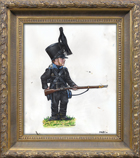Simple Wargame Rules'CARDS & CONFUSION' based on 'Simple musket era toy soldier rules' by Mike Fischer. Right click and 'save target as' to download A4 Rules .zip fileSetup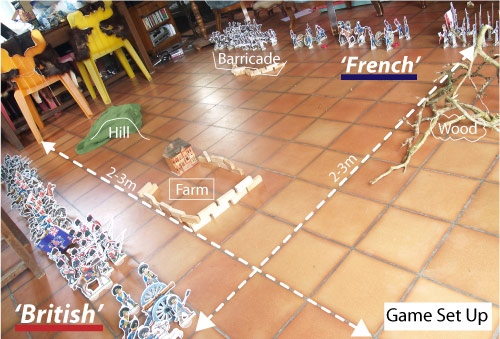 Find a space 2 m wide, 3 m long. Players place 4 objectives (e.g. small hill, walled field, bridge, village, woods) fairly spaced across. Each side should have
Units should be arranged near the back line whilst trying not to watch your opponent! Cut the pack to see who moves first. In the battle pictured here the sides were French
British
Course of play
A player may take all 3 actions in one turn but is never required to move, fire, or conduct combat if he does not choose to. 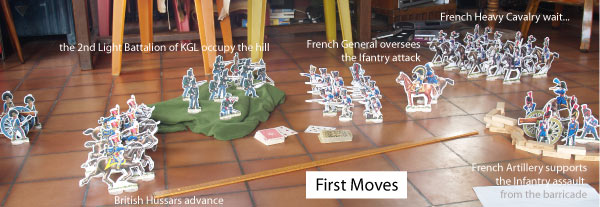 MovingInfantry and artillery may move up to 20cm, cavalry may move up to 40cm, and, can pivot on the centre man in the front rank any number of degrees (artillery pivot on the cannon axle or not). Generals move 60 cm any direction. Units must stop when any of their men are less than 20 cm from enemy troops who are facing them. One may pass by enemy units that are as little as 20cm away as long as the units don't face one another directly. Units may pass through friendly troops.
Units with no men still in ranks (all remaining are confused) may move in any direction as an unorganized mob up to 30 cm, but may not pass closer than 15 cm from enemy troops and must run away if the enemy approaches. Fleeing units unable to go the entire 30 cm are eliminated. 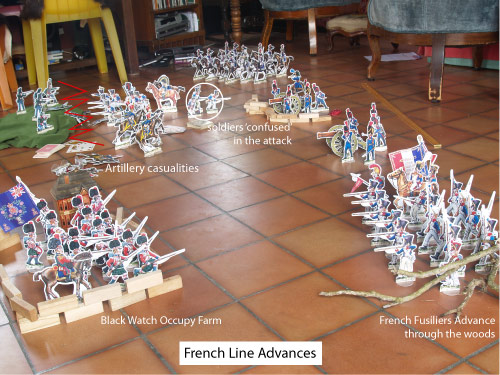 RallyingA player may rally (regroup) a unit if it has at least one man remaining in ranks and none are 20 cm or less from any enemy men in ranks who are facing them. The unit may return to ranks as many men who are already in ranks that turn, plus one extra man for a general and/or aide-de-camp next to them. If it has no men in ranks and all of its men are 40 cm or more from any enemy men in ranks facing any direction, the commander must first be moved next to the unit in order to rally them. Artillery gunners that have fled from their cannon return to it when they rally, 25 cm per turn, before they can fire it again. Long Range Artilery FireCannons may fire at any enemy unit in a clear line of sight between 10 and 130 cm away and 45 degrees left or right. One man is killed in the target unit. If the target unit is engaged in combat, the killed man is left where he fell. No men are confused when a unit is hit by long range artillery. Only one artillery gunner is needed to fire a cannon. 1 cannon ball marker is used if the target unit is in the open or in soft cover such as woods; 2 balls if the target unit is behind a solid wall, and 3 if the target unit is behind a redoubt or in a trench. 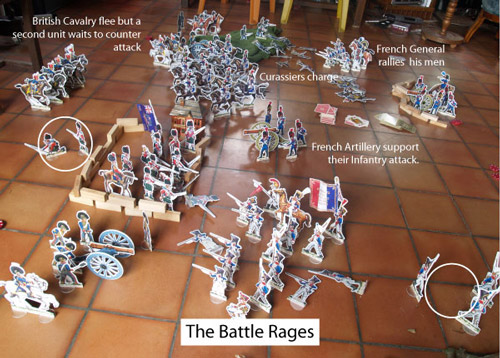 CombatCombat is between all types of opposing units (infantry, cavalry, artillery) that are 20cm or less apart, with at least one of the opposing units facing the other. A player may only conduct combat once per turn per unit, but an opposing unit can be engaged by more than one unit. Cavalry may not initiate combat with an enemy unit behind a wall or in woods. To conduct a combat, each player turns up the top card in their deck. If one card is higher than the other (, Jack = 11, Queen = 12, King = 13, Ace = 14), one enemy man is killed. An infantry or artillery unit defending behind a redoubt, solid wall, or in a trench adds 3 to their card. The winning player gets to choose which one of the enemy men to kill and which one(s) is confused. When the first man is killed,one man is confused, turns and runs to the rear of the formation, when the second man in the unit is killed, two more men are confused, turn and run, when the third man is killed, three more men are confused turn and run; etc. To keep track, leave killed men on the field until the engagement is over. If both cards are equal in value, both sides lose a man killed, and the number confused is based on the number of men already killed in each unit; these are selected by the opposing, not owning, player. Officers, drummers and flag bearers are the last to be killed or become confused. Special combat situatuionsWhen artillery wins a combat, one enemy man is killed and the number of men confused is half to the number on the winning card, so up to 5 men may be confused (Jack, Queen, King each cause 3 men to run, an ace only 1, odd numbers round up). Always use the face value of the card for the number of men who are confused, even when defending behind a redoubt, wall, or in a trench. A win by cavalry causes 1 more man to become confused than would normally. A win by a unit attacking the flank (side) or rear of an enemy unit causes 2 more enemy men to become confused than would normally.  Winning the battleAs soon as men in ranks of one side completely occupy, or were the last to occupy, three of the four objectives, that player wins. Having been the last ones to pass through an objective counts as being the last to occupy. Experiment with these rules. You can decide to play a total route game in which the winner must destroy an opponent's army (killing or confusing and so capturing any survivors). Or perhaps a game in which one army is bigger yet another army is already holding three of the key objectives. E-mail me any alternatives and I'll try to post them up here! |









